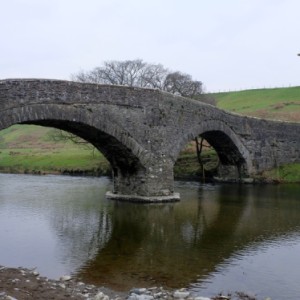Lowgill Viaduct
Although there was no need for tunnels on the Ingleton/Lowgill line, there were many bridges and three impressive viaducts. This is Lowgill Viaduct and it is just a short distance south of the station, the site of which we were at yesterday. The best photo from above will be blipped when I get a bright day; today was as dull as dull can be.
So we are below the viaduct, the same place I was five years ago when I was following Andy Goldsworthy’s footsteps along the drove road from Scotland. It is an interesting place to be, as you have the old drove road with its wide verges for the cattle, the narrow farm lanes which would once have been tracks for horses pulling carts. Then along came the huge viaduct carrying the railway branch line. To the left is the West Coast main line railway, still very much in use. And just next to the railway is the M6. A history of transport coverging in this one place.
And that’s not all. If you follow the narrow road through the viaduct and continue along the lane for a short distance it goes steeply down to the River Lune and there is an old packhorse bridge (see extra). It is not known when it was built, but records show it was repaired in 1702, so it could be 16th century. It is a rubble masonry bridge with two separate arches and would have been in use when goods were carried by packhorse. It is now part of the Dales Way and carries walkers over the river.
The viaduct is built on a curve and has eleven arches, each 14m high. It does not cross the Lune, but a small tributory. It was built mainly to span the gap caused by the valley side, as can be seen in the photo.
Little North Western Railway 2


Comments
Sign in or get an account to comment.


